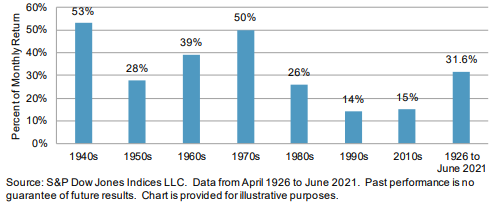Introduction
Investors seeking long-term growth and income have long turned to dividend-paying stocks as a cornerstone of their portfolios. Dividends, which are payments made by companies to their shareholders as a portion of their earnings, have been an essential driver of total returns in the stock market. In this article, we will delve into the extent to which dividend income has contributed to the total returns of stock portfolios for decades.
Dividend Income as a Percent of Monthly Total Return of the S&P 500

Dividends and Their Importance
Dividend income is often seen as a sign of a company’s financial health and stability. Companies with a history of consistent dividend payments are typically well-established, profitable, and less likely to be affected by market volatility. This stability makes dividend-paying stocks attractive to income-seeking investors, who rely on the steady stream of cash to meet their financial needs or to reinvest for compounded growth.
The Role of Dividends in Total Returns
Total returns consist of two components: capital appreciation, which is the increase in the price of the stock, and dividend income. To understand the extent to which dividends have contributed to total returns, we need to examine their impact on a broad market index and individual stocks.
According to S&P Global, dividends have contributed approximately 32% of total return for the S&P 500, while capital appreciation contributed 68% between April 1926 and June 2021. In some periods, dividends have been even more critical. For example, during the 2000s, a decade characterized by two significant market downturns, dividends accounted for almost 80% of the S&P 500’s total return.
In the case of individual stocks, dividends can make a substantial difference in long-term performance. According to a study by Ned Davis Research, dividend-paying stocks in the S&P 500 outperformed non-dividend-paying stocks by an average of 1.9% per year between 1972 and 2020.
Factors Driving the Importance of Dividends
Several factors have contributed to the increasing importance of dividends in investors’ total returns:
- Lower interest rates: As interest rates have declined over the past four decades, income-seeking investors have turned to dividend-paying stocks for higher yields and lower tax rates compared to bonds and other fixed-income investments.
- Increased focus on income: The aging population, particularly the baby boomer generation entering retirement, has shifted the focus of many investors towards income generation rather than pure capital appreciation.
- Dividend reinvestment: Investors who reinvest their dividends can benefit from the power of compounding, significantly enhancing their long-term returns.
Conclusion
Dividend income has played a significant role in total returns for stock portfolios for decades. With a substantial contribution to the performance of both individual stocks and broader market indices, dividends have proven to be a critical component of long-term investment strategies. As the global economic landscape continues to evolve, investors would be wise to recognize the potential benefits of dividend income and consider incorporating dividend-paying stocks into their portfolios for a balanced approach to wealth creation.
At Fintegrity, we specialize in creating custom-tailored portfolios of individual securities, including a significant focus on dividend-paying stocks, adjusted to fit each client’s unique needs and investment goals.
Don’t miss out on the power of dividends. Contact Fintegrity today at 201-266-2829 and let us guide you towards a portfolio that works harder for you!

0 Comments